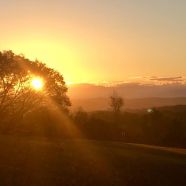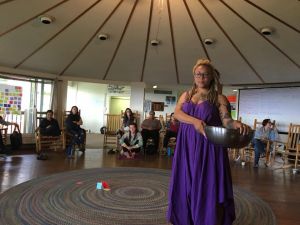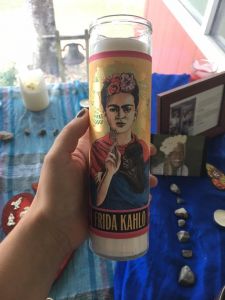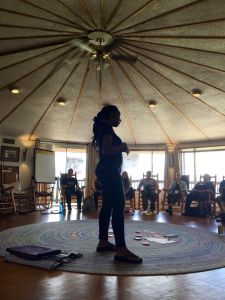Ghosts We Carry, Healing We Practice: Medicine for Liberation
Written by Jardana Peacock with contributions from Amber Burns-Jones, Deitrah J. Taylor, and William Brummett
The gray fog spun in swirling webs around the full moon.
As I watched the mist claw at the sky, I thought, How many ghosts do we carry in a world with so much racism and pain? In a world where my Latinix neighbors fear deportation when dropping their kids at the bus stop, or when last week on an airplane a white woman berated a Black woman flight attendant, treating her like a child as most of the passengers silently watched. Hate and violence has long diseased the soil and souls of the United States. With the rise of white supremacist rallies and the racist diatribe of the 45th president, this violence is revealed further, an untended wound. Our world is one where the violence of oppression is all around us, inside of us, and between us. How many ghosts do we face? Often, the ghosts are pushed away, forgotten, and unspoken. But are they gone?
As philosopher Alexis Shotwell reminds us, “We meet this (white) ghost when we learn about the history of genocide and colonization on this continent; we meet it when we begin to understand how many people were murdered, how much land was stolen, how many Indigenous children were taken from their families and places and forced to not speak their language, how much water and soil was poisoned. We meet this ghost when we start to know how these places were built through the bodies and blood of enslaved people.”
In the circle room at the Highlander Research and Education Center, located in east Tennessee, the first Liberation School cohort gathered. We began with the ritual of singing, voices blending with voices and bodies swaying side to side. Ancestors filled the round walls, windows gazed toward the Smoky Mountain sunrise. The rocking chairs moved back and forth with the bodies of those who were present and those who were not.
They murmured ways forward beyond oppression and hate. There was Rosa Parks, who trained at the Highlander Center, Dr. Rev. Martin Luther King Jr.; Anne Braden, a white anti-racist organizer from Louisville, Kentucky—and a mentor of mine; Ella Baker, who fortified the young people of the Student Nonviolent Coordinating Committee (SNCC); and Zilphia Horton, a songstress and cultural organizer who played the accordion and taught songs of struggle and resistance to coal miners and civil rights leaders. Then there was Septima Clark, an educator who started the Citizenship Education Schools in the South Carolina sea islands. The Citizen Education Schools taught Black folks how to read and write, using popular education methodology (the concept that people are the experts of their own experiences), so they could pass the voting test and vote in the 1950s and ’60s. Many folks don’t know about all of these ancestors; however, they were the founders who built the southern Black Liberation Movement. They represent a long lineage of movement builders and justice crafters that helped build a better world that we all have an opportunity to step into and build onto.
Liberation School participants built an altar of liberation. Our stories were ones of pain and freedom, as each blue glass box, holding the elements of earth, sea, and desert, a political poster, and a protest megaphone were shared with vulnerability and with hope and placed on the yellow-clothed altar table.
In that room, people came out of the spiritual closet. In our movements for liberation, sometimes faith and spirituality aren’t always welcome. Religion has been a part of oppression too, and yet Liberation School holds that it is spirituality that returns us to the belonging that oppression severs us from. So, we shared blessings, prayers, ceremony, and chants across spiritual and faith traditions. We moved in our bodies through embodied practice, because this is part of acknowledging the ghosts too. The work of justice is ancestral work. Without spirituality, without healing, how would we survive the violence, one that has torn people from people, people from place, and people from the deep roots of interconnection—that from which we all belong and yet so few of us feel.
And we sang a song by Deirdre Smith: “We’ve got all our medicine, right here.”
And the visions and voices of southerners from Liberation School shape the landscape of our movements and world—they always have.
Amber Burns-Jones: My vision of justice is a world in which every living being is cherished, held in positive regard, and respected. Resources are dispersed in an equitable way and we (humans) receive the gifts of the Earth so that she is not left depleted.
This radical transformation must begin at the root . . . self. I view self as a microcosm. If we do not prioritize the healing of self, we will continue to perpetuate the same harm that we are working to correct. When we heal individually, we can do so as a collective.
Liberation School
In October 2017, about thirty changemakers, who believe that centering spirituality and healing in our movements for change is essential, gathered for the inaugural cohort of Liberation School. Liberation School is a dream, a vision, a hope for our movements that bring together changemakers working at the intersections of healing and spirituality from the global and US South and beyond to fortify, heal, and build over nine months toward internal and external liberation in their bodies, relationships, and inside their communities in a sustainable way. Liberation School posits that when practice meets action, we fertilize a sustainable, long-term movement for change.
Changemakers experience primary and secondary trauma from working with traumatized populations and because of the physiological impact of the climate crisis. Untreated, this trauma leads to burnout and other health-depleting conditions.
Additionally, untreated intergenerational trauma that people carry within themselves continues to perpetuate systems of internalized and external oppression.
Deitrah Taylor: Often what triggers people to become involved in seeking justice and oneness with Spirit is a personal experience of exclusion, and/or injustice, and the realization that one is not alone in this experience. Negative experiences leave wounds. Sometimes these wounds leave scabs and are not quite healed, other times the wounds leave scars. In my experience wounds have been isolating. Nevertheless, as people continue to work to build justice movements, wounds present themselves as discord. This discord is not the healthy exchange of a difference of opinion or idea but pain that often results in the individual leaving the community. Sometimes this is necessary for a person to heal and sometimes the person never goes through the healing process. As practitioners of justice we must center individual healing and support one another in healing work. The community should provide a loving and supportive space that promotes openness and honesty.
The wounds can be our answers and also serve to separate us from the past and future. What does it take to heal, to address the wounds of pain that we carry? How have Southerners been doing that work? Often the healing occurs when the heart opens to what’s possible. We learn to open through practice, through poetry, through facing the past and knitting a different future.
Amber: Healing (for me) tastes like sunshine and melted honey—warm, comforting, sweet, nourishing, and shareable.
In the mornings, sun spooled around our feet, hands pressed together, bodies rooted in the footsteps of all the ancestors we brought along, we faced the ghosts as we sang.
“We are here, standing strong, in our rightful place.”
Tufara Waller Muhammad, former cultural director at the Highlander Center and a faculty member at the Liberation School, says that when we sing, we create an unstoppable force. Our voices knitted together and rose to the ceiling, blanketing everyone with its sweet vibration. To interrupt oppression, we build community. We match our voices together, through chanting, through song weaving, and through stories.
But there are still many ghosts.
Facing the truth of this violence requires patience. We must do it slowly, we do it alone, and we do it with others.
Healing in Movements
Amber: Healing is hard. It takes courage and a willingness to face uncomfortable truths.
But people build resistance in their resilience, in their healing.
Spiritual activist Bayo Akomolafe states, “Slowing down is taking care of ghosts. The idea of slowing down is not about getting answers; it is about questioning our questions. It is about staying in the places that are haunted.”
In the slowing down, we exhale. In the exhale, trauma releases, the ground strengthens, and we face the pain of the world we carry, the world that is. When we face the pain, we can begin to build a future of belonging and liberation.
However, to slow down is painful. In a world of chaos, families are being torn apart, bodies are being decimated by war, and the planet experiences daily environmental terrorism by its human inhabitants. To slow down is to be weak, to fail, to allow oppression to continue unchallenged. Right?
But do we face the ghosts with urgency and speed, or is that another wound untended? Don’t we allow oppression to thrive when we don’t heal and connect? See, oppression has stripped us from being able to easily access a felt sense of interconnection with the planet, each other, and ourselves. The cost of this is great; it is a spiritual crisis that separates so many of us from understanding and living as sacred and divine beings in relationship. In the pause, we return, in our relationships, we return—to connection—one of the greatest forms of resistance is to connect, to heal, to strengthen our resilience.
Will Brummett: I have seen the power of activists centering their own healing by slowing down to listen to themselves and their bodies at stone circles at the Stone House. I have seen Appalachian youth sitting around a campfire and healing their collective spirit through song, homegrown food, and vulnerable story sharing along with their policy planning. I have seen activists incorporate and invite an embodied knowledge into the space by offering yoga, mindfulness meditation, and healing accompaniment at Liberation School.
Systems of oppression have traumatized us, creating a cycle of violence that we cannot break out of unless we heal, connect across culture, and make art to suture these divisions and actualize a world of interconnectivity. As Winona LaDuke articulates, “How does a community heal itself from the ravages of the past? I found an answer in the multifaceted process of recovering what is “‘sacred.’”
What is sacred? Isn’t it returning to each other, ourselves, and to actualize interconnectivity? Interconnection that is scientifically proven and spiritually felt.
Deitrah: When I think of healing I think of being made whole. Wholeness to me means being at one and at rest with God/Spirit/Universe/Light/Divine. To experience this one must be healed physically and/or spiritually, accept gratitude for the healing and in agreement with the Divine. A lack of dis-ease.
Perhaps returning to wholeness requires us to examine our brokenness together. To invite the ghosts in, to face our history and the truth of what it does to us when we avoid it. Without healing can our ghosts ever be truly liberated?
Italian physicist, Carlo Rovelli, states, “We are made up of the same stardust of which all things are made.” This is the very core of practices for liberation. Human beings are sacred and yet, they/we are also the reason for the most painful destruction and violence. If we do not face our ghosts, the systems of destruction and violence of oppression will persist.
Will: As a white male, I commit to creating a world where cis white men understand themselves and their own trauma, pain, and healing in new ways that allow us to own our difficult ancestral past while also stepping into movement support work in a more holistic, vulnerable, and humble way that supports what POC/trans/women/LGBTQIA activists are already doing.
Healing is a map to face the pain, to create a different way. It isn’t usually easy but it is necessary.
Healing and spirituality is vital to the health and success of our movements for change in the South and beyond. Without healing and health, who will lead the changes we need in this country and world? When we don’t center healing in how we organize, how often are we incorporating violence into the work that is supposed to be about liberation?
Amber: When I nurture myself, tend to my wounds, and gently touch where it hurts; I learn to treat others with the same tenderness.
Will: We cannot destruct the systems that oppress us by destructing the bodies, spirits, and communities that also hold us. To do so is to let the systems of white supremacy, capitalism, and colonialism win by martyring ourselves. The tools and approaches we use to achieve change in our communities must reflect the world that we want to create and live in.
We must embody our values, step into our imaginations of a world yet created and realize that now, we must build a movement of racial and environmental justice that centers around healing and sustainability.
It is the only way to answer our ancestors’ calls to heal, to change, and to live liberation. The future is being created now and the medicine is in our bodies, our longings, our spirits, and in working with our ghosts.
Amber: We enter movements with trauma and pain. Healing is important in our movements for justice because when we are able to heal, we are free to imagine a world we have never known. We are free to show up as our best selves and be present/grounded in the work. The movement needs us to heal because WE ARE THE MOVEMENT.
We strengthen our resilience when we center spirit and healing as the path toward enacting lasting collective liberation. When people connect across difference, sharing stories, facing their pain, and pooling together strategies for building a more just world, we begin to heal our ghosts. The medicine for our future is within us and around us. Moon beaming, hands clapping, voices raised:
“We’ve got all our medicine. . . . .
Right here.”
Stay connected with Liberation School here: http://www.liberatoryleadership.org/the-school.html
Additional Readings
adrienne maree brown, Emergent Strategy: Shaping Change, Changing Worlds
Bayo Akomolafe, Slower Urgency: We Will Dance with Mountains: http://bayoakomolafe.net/project/a-slower-urgency-we-will-dance-with-mountains/
Susan Raffo, How We Talk about Bodies Matters: https://susanraffo.blogspot.com/2017/10/how-we-talk-about-bodies-matters.html?m=1
Alexis Shotwell, Is It White Shame?: https://alexisshotwell.com/2017/08/13/white-shame/
Contributors
Jardana Peacock is director of Liberation School. She is a spiritual teacher and healer who has been working in Southern social movements for over a decade. She has worked with hundreds of changemakers globally to address trauma through an anti-oppression lens. She is author and curator of Practice Showing Up: A Practice Guidebook for White People Working for Racial Justice and is currently working on a new anthology with Rusia Mohiuddin with the working title, “Sustenance for Social Change: Practices and Strategies for Changing the World.” She is based in Kentucky. You can reach her at www.jardanapeacock.com.
Amber Burns-Jones is a writer, artist, and speaker based in Louisville, Kentucky. Amber helped found and performs with two choreo-poetry troupes, S.H.E.! (Solidifying Her Evolution) and most recently, Mother Tongue Techniques. In addition, she’s a founding organizing team and faculty member of Liberation School.
Deitrah J. Taylor lives in Perry, Georgia, and is a public historian and dramaturge. She has been passionate about social justice from a young age. As an educator, she always incorporates social justice into her teaching and programming. She is a participant in the inaugural cohort of Liberation School.
William Brummett is an activist and artist. He helped found Stay Together Appalachian Youth (STAY), a youth-led project in Appalachia that works to develop economic opportunities for young people to stay and thrive in the region. He’s from Jefferson City, Tennessee, and current resides in Boston, Massachusetts. He’s a founding organizing team and faculty member of Liberation School.










